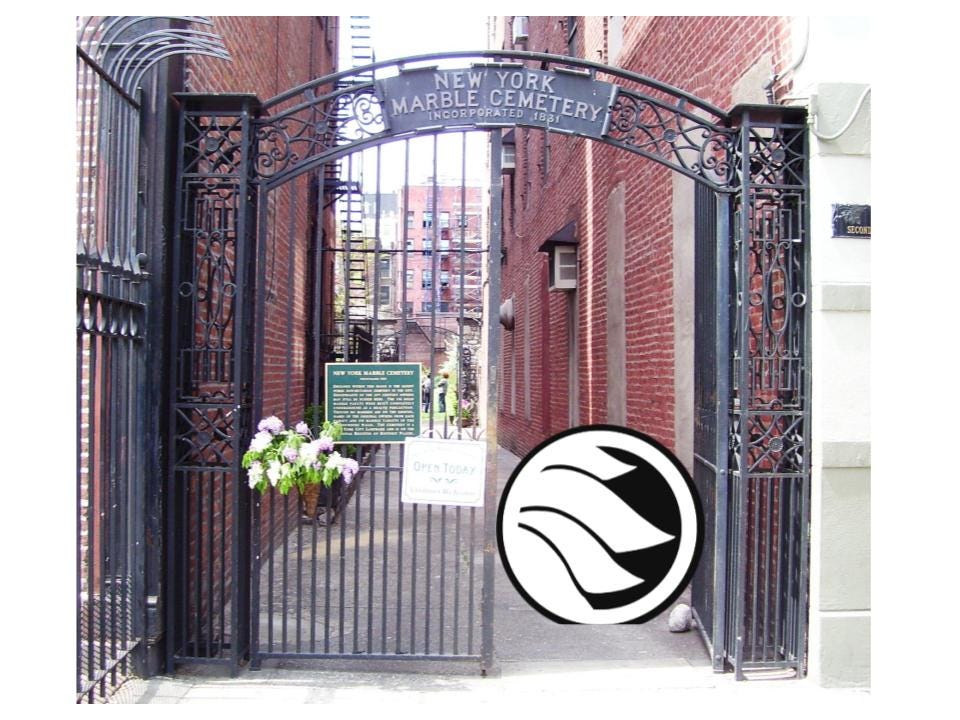The cemetery holds the bodies of 2,000 colonizers – their current regulations would make these ghosts proud.
One busy weekday in October, I took my mom to check out the now defunct New York Marble Cemetery a few blocks east of campus (not to be confused with the New York Marble Cemetery, which is one block away). The oldest non-denominational cemetery in town, I had been drawn to its arched doorways and historic plaque wedged between a funeral home and an antique store.
After charming a workman to let us (two white women) behind the door to have a look, we were greeted by a plush lawn and bushes of flowering hydrangeas. It was luxurious and strange. The landscaper told us that he was administrator of the cemetery and that it is now an event space that you can rent for weddings, parties, photo shoots, etc.
The cemetery is lined with walls bearing plaques commemorating those buried there. There are no traditional plots as the dead were piled in locked underground vaults due to the yellow fever epidemic in 1822. These vaults are made of Tuckahoe marble, hence the name “Marble Cemetery “. The epidemic of 1822 was caused by trade with the Caribbean – this trade was the work of violent colonizers, many of whom are now buried in the graves.
The intense colonial history and overwhelming presence of death in an event space that hosted Stella McCartney parties (according to John Harney’s piece for the New York Times titled “In the East Village, Fun and Fashion Beneath Tombs”) is a contradiction that feels like quintessential New York. There is a deep desire here to erase history and for every free space to become “a ring of superior bourgeois luxury”, to borrow a description from Samuel Delaney’s non-fiction book. Jime Square Red, Time Square Blue on the development of this region from the 1960s to the 1990s.
Indeed, if you are unfamiliar with the storied history, the cemetery can look like a peaceful gem of green space surrounded by taller buildings. In my research, I discovered that the back of the cemetery is bordered by Kenton Hall, a homeless shelter. A 2008 New York Times article by Gregory Beyer reveals that considerable effort was made to prevent shelter residents from accessing the cemetery for use as a park. Indeed, a lot of effort has gone into keeping the cemetery pristine, polished and exclusive – in fact, they are only open one Sunday a month from April to October, just seven days a year. Harney writes that cemetery administrators “added locked screens” to keep Kenton Hall neighbors out. It’s a half-acre garden that’s only available to publicists and their guest list or anyone who wants to spend $2,500 or more on rentals. The measures are indicative of how homeless people are being treated across the city, especially amid sweeps of homeless encampments by Mayor Eric Adams’ administration.
I felt the grass let go under my feet and I imagined the arches that the lawn covered. Bounded by 2nd Avenue, East 2nd Street, Bowery and East 3rd Street, their website states that in this block over 2,000 bodies are buried. I asked the landscaper if people find the place scary when they throw parties there, which he vehemently denied. He also expressed frustration with people simply entering the cemetery when the door is unlocked, describing it as an intrusion. I don’t know how he can blame them, though – the intriguing doorway and wonderful name are sure to pique the curiosity of tourists and residents alike.
However, the way the space asserts ownership of the land and marks the space as private is consistent with the history of the people buried there. It was the people who helped shape the infrastructure and superstructure that determined the city’s performance – including former New York Mayor Aaron Clarke, who was buried there in 1848. Brookes Wrampelmeier writes on the cemetery page that “during the War of 1812, he was private secretary to Governor Daniel Tompkins of New York and was also a brigade quartermaster in the militia. Anne W. Brown writes that Francis Markoe, buried in the cemetery the same year, was descended of a family that operated a sugarcane plantation in the Danish West Indies.These people could be described as among the many villains in history, but their final resting place is nevertheless perfectly preserved.
Today, this legacy of exclusion continues. People living next door are kept away, but descendants of those buried there are encouraged to arrange visits whenever they visit the city. This story can only be read as an indictment of how property and access work in New York. As my mom and I continued to explore the space, the landscaper waited impatiently and ended up rushing us. He had to get ready for another hire.

